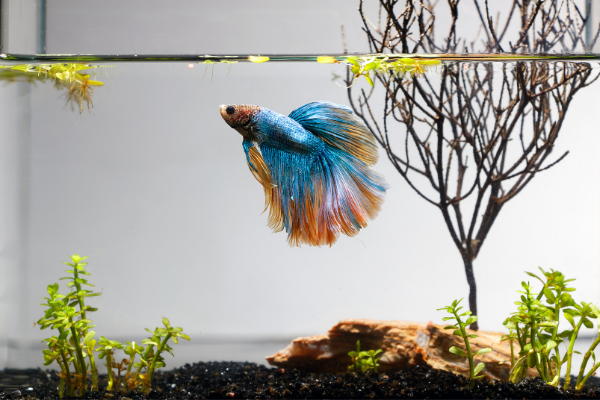THAILAND
Bubble Battles
By Chadd McGlone
Chapel Hill, NC, United States
Strolling through the aisles of a pet store, you might spot colorful, long-finned fish swimming one by one in small bowls. You might wonder if they feel lonely and why they develop such attractive fins when no other fish are around to notice.
The reason why these creatures, known as Siamese fighting fish or bettas, are kept in isolation is that they are quite territorial. In fact, the males can be so hostile toward each other that it is illegal in some locations to place them in the same container.
When a male betta thinks he sees another male betta, even iit’s just his own reflection in a mirror, he puffs up his fins and expands his gills to prepare for an attack. Once a battle begins, two bettas may fight for hours until one kills the other. Ironically, when placed with any other type of fish, bettas are very peaceful.
Fierce Fathers
In the wild, bettas live in the stagnant water of southeast Asia’s rice paddies, where their aggression serves to protect their territory, especially when raising their offspring. The male bettas care for their young from egg to adolescence.
This process begins with a daddy-to-be claiming a suitable location. Next, he will spend hours releasing gulps of air just below the surface of the water to build a bubble nest. These fragile structures are about two inches in diameter and require constant attention.
Once the nest is built, the hopeful father fish flares his fins and gills to attract a female. Once she has released her eggs, the male fertilizes them, and then gently places them in the bubble nest. He then chases the female away, because it is his job to provide protection from now on.

The male has an important role during the eggs’ incubation, which lasts for 24 to 36 hours. If any eggs start to sink, he captures them. He maintains the bubble nest on the surface to make sure it gets plenty of oxygen. Once the hatching starts, the youngsters float with their tails down before they start to swim horizontally.
Origins
How did bettas come to be sold as pets? Sometime before the 18th century, they caught the attention of Siamese villagers in a region now known as Thailand. For sport, the men would pit two fish against each other to determine which one would continue fighting the longest. Bettas looked very different from what you see now, as they were a greenish brown hue with shorter fins.
Eventually, villagers began breeding the fish to be more and more combative. Significant wagers would be made on the outcome of betta battles. Some victorious contestants won such prizes as houses and family members!
In the 1840s, the popularity of bettas skyrocketed when the King of Siam developed an interest in them. He would entertain visiting international diplomats with the fish’s hours-long altercations. By the early years of the following century, descendants of the King’s breeding program were imported into Europe and North America.

Color Replaces Combat
Hobbyists began selecting the most vibrantly colorful fish to breed, rather than the most pugnacious. Today, bettas come in a multitude of hues with a variety of fin shapes. If you add a betta to your aquarium, you will appreciate its beauty and calm. Make sure you always have a lid on, though, because bettas have been known to jump out of their containers. Even if you find your fish gasping on the ground, it might still be okay, because bettas have the ability to absorb oxygen from air. Just don’t let it see another male!
Have a suggestion for this story? We’d love for you to submit it!


Blank
Blank
Math Resources
- A good brood of baby bettas is about 40 fish. Say you breed fish and have five males, each with an average-sized brood. How many total fish do you have?
- The number of baby fish in the broods of these five fathers are 35, 54, 42, 46, and 52. What is the average number of fish for a brood?
- A breeder can sell each individual fish for US$6. The shipping cost is US$0.50 per fish and the administrative costs, like marketing and billing, are US$0.10 per fish. How many fish does the breeder need to sell to make an annual salary of US$45,000? How many fish per month does she need to sell?
- It takes a betta three hours to make a square nest that is eight millimeters on each side. How long will it take him to build one that is 56 millimeters on each side?
- You’ll need square tiles for this question. Some people say you can have two male bettas together in a tank as long as you have lots of plants and plenty of space for them to each claim a spot. You need at least three female bettas per male. Using square tiles, imagine each tile is a gallon of water. If you have 24 square tiles, how many different ways can you arrange those tiles to form a rectangular tank? Make a proposition about the patterns you see. Repeat with a different number of tiles.
- You’ll need cubes for this question, where each cube represents a gallon of water. Arrange the cubes to form a rectangular prism to represent the fish tank. How many square units are on the top of this “tank”? Arrange the cubes in different rectangular prisms and determine the surface area of the top of the tank. List all you found. Make a proposition about the patterns you see.
Extension Questions
- What do you think about pet stores keeping bettas isolated in small, dirty bowls? Should the store keep them in a more natural habitat? What if keeping them in such a habitat means you have pay more for the fish?
- Do you think it’s right for people to breed bettas to fight each other as sport? If it’s not right for animals to fight, do you think it’s okay for people to fight for sport?
Explore Further
- Informational website on bettas
- Another website with information on bettas
- The final website we’re going to list on bettas
- Three-minute video on how to set up a betta tank
Share Your Story
Write your own Global Math Story and send it to us!
Sorry, the comment form is closed at this time.